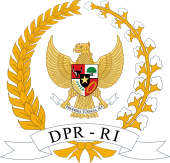Speaker of the People's Representative Council
|
People's Representative Council Dewan Perwakilan Rakyat |
|
|---|---|
 |
|
| Type | |
| Type | |
|
Term limits
|
None |
| Leadership | |
|
Speaker
|
Setya Novanto, Golkar
Since November 30, 2016 |
|
Deputy Speaker
|
Fadli Zon, Gerindra
Since October 2, 2014 |
|
Deputy Speaker
|
Agus Hermanto, Demokrat
Since October 2, 2014 |
|
Deputy Speaker
|
Taufik Kurniawan, PAN
Since October 2, 2014 |
|
Deputy Speaker
|
Fahri Hamzah, PKS
Since October 2, 2014 |
| Structure | |
| Seats | 560 (5 vacant) |
 |
|
|
Political groups
|
Government (The Great Indonesia Coalition) (386) |
| Authority | passing laws and budgets (together with the President); oversight on the executive branch |
| Elections | |
| Open list proportional representation | |
|
Last election
|
9 April 2014 |
| Meeting place | |
 |
|
|
Legislative Complex Jakarta, Indonesia |
|
| Website | |
| www |
|
The People's Representative Council (Indonesian: Dewan Perwakilan Rakyat, DPR), alternatively translatable as the House of Representatives or as the House of People's Representatives, is one of two elected national legislative assemblies in Indonesia.
Together with the Regional Representative Council (Dewan Perwakilan Daerah, DPD), a second chamber with limited powers, it makes up a legislative body, the People's Consultative Assembly (Majelis Permusyawaratan Rakyat, MPR). Currently there are 560 members, following the 2009 elections, all elected.
The house has been the subject of frequent public criticism due to perceived high level of fraud and corruption.
In 1915, members of the Indonesian nationalist organisation Budi Utomo and others toured the Netherlands to argue for the establishment of a legislature for the Dutch East Indies, and in December 1916 a bill was passed to establish a Volksraad (People's Council). It met for the first time in 1918. Ten of its nineteen members elected by local councils were Indonesians, as were five of the nineteen appointed members. However, it had only advisory powers, although the governor-general had to consult it on financial matters. The body grew in size to 60 members, half of who were elected by a total of 2,228 people.
In 1925, the Volksraad gained some legislative powers. It had to agree to the budget and internal legislation, and could sponsor laws of its own. However, it had no power to remove the governor general and remained nothing more than a gesture.
In 1940, after the German invasion of the Netherlands, and the fleeing of the Dutch government to exile in London, there was a motion calling for an inquiry into turning it into a quasi-legislature, but this was withdrawn after a negative response from the government. In July 1941, the Volksraad passed a motion calling for the creation of a militia made up of up to 6,000 Indonesians In February 1942, the Japanese invasion began, and in May 1942 the Dutch formally dissolved the Volksraad. It was replaced by a council made up of heads of departments.
...
Wikipedia
